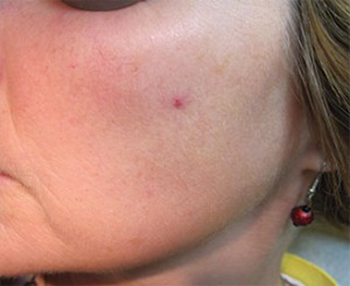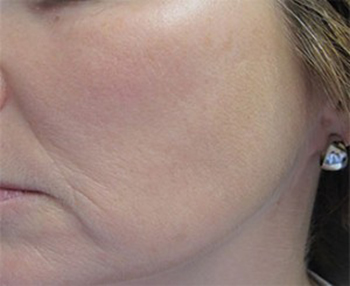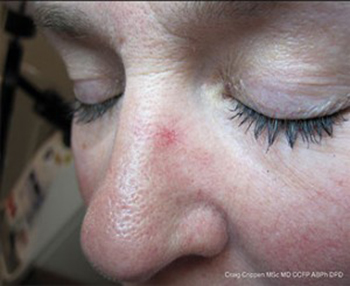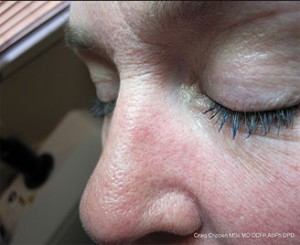Rosacea Therapy
Reduce Redness with Rosacea Therapy
Over 14 million people have Rosacea, a skin condition that produces excessive redness and blushing of the cheeks, nose and chin. In more severe forms, acne-like pustules or thickening of the nose skin will produce an abnormality known as rhinophyma. Rosacea is a chronic skin condition most commonly found on the facial skin, but also can be located on the chest, neck, ears or scalp. Rosacea is primarily found in people over the age of 30 with fair skin who flush or blush easily. This condition can run genetically, affecting more women than men. Men, however, will often have a more severe form of Rosacea. If you have symptoms of Rosacea, you may be a candidate for Rosacea Therapy.
IPL™—Intense Pulsed Light—is an FDA approved, breakthrough technology that uses a broadband spectrum of light that can alleviate the Rosacea symptoms. Rosacea is treated by using a combination of IPL™ treatments and light chemical peels, along with topical applications. There is no cure for Rosacea, however, these treatments will help control the symptoms.
*Individual results may vary

*Individual results may vary
FAQ's
This incredible therapy is based on disbursing high intensity pulses of light through a handpiece that is gently applied over the treated area. IPL™ treats only targeted areas, leaving the surrounding skin untouched.
- Flushing – Many people with Rosacea have a history of frequent blushing or flushing. This facial redness may come and go, and is often the earliest sign of the disorder.
- Persistent Redness – Persistent facial redness is the most common individual sign of Rosacea, and may resemble blushing or a sunburn that does not go away.
- Bumps and Pimples – Small, solid, red bumps or pimples often develop. While these may resemble acne, blackheads are absent and burning or stinging may occur.
- Visible Blood Vessels or Spider Veins – In many people with Rosacea, small blood vessels become visible on the skin, especially on the chin, cheeks and nose.
- Skin Sensitivity or Dryness – Patients with Rosacea often experience very sensitive skin.
Yes. This patented, FDA-approved technology safely and effectively treats rosacea. Advanced light systems have been used safely on millions of patients of all ages worldwide.
Immediately after the treatment you will experience some minor redness which typically lasts only a few hours. You can expect to immediately return to normal activities.
- Discontinue sun tanning and the use of tanning beds and self-tanning creams 4 weeks before and throughout the treatment course. This will reduce the chance of skin color changes, and development of new lesions.
- Always use an SPF 30 or greater sunscreen on all exposed treatment areas and re-apply every 2 hours throughout the day. Wear protective hats and clothing.
- Discontinue use of exfoliating creams such as Retin-A and other skin exfoliating products 2 weeks prior to and during the entire treatment course.
- Discontinue use of Oral Isotretinoin/Accutane for 6 months prior to and during treatment. Accutane changes the underlying structure of the skin which may cause an increase skin sensitivity to light.
- If you have a history of Herpes outbreaks in the area of treatment you should consult your Primary Care Provider for medical evaluation and possible antiviral therapy prior to treatment.
- An accurate diagnosis, by a Physician, of abnormal lesions or brown spots prior to treatment is necessary before treatment of lesions. Failure to do so, may delay proper treatment.
- A mild sunburn-like sensation is expected. This usually last 2-24 hours but can persist up to 72 hours. Mild swelling and/or redness may accompany this, which usually resolves in 2-3 days. In some cases, prolonged redness or blistering may occur.
- Apply cool/ice compresses and/or 1% Hydrocortisone cream to treatment areas for 10-15 minutes every hour for the next 4 hours, as needed, to reduce discomfort or swelling.
- The treated area can be gently cleansed and polysporin may be applied if needed.
- Direct sunlight to the treated area should be avoided. Daily application of an SPF30 or greater sunscreen is recommended to prevent development of new lesions.
- Pigmented lesions may initially look raised and/or darkened with a reddened perimeter. The lesion is usually healed in 7-21 days, but may take 4 weeks to completely fade.
- Do not pick, scratch or remove scabs. This will prevent unwanted side effects.
- Be aware of the likelihood of coincidental hair removal in the treatment area with a PhotoFacial.
- Until redness has completely resolved avoid swimming, hot tubs/Jacuzzis and activities that cause excessive perspiration.
Before And After Rosacea Treatments






